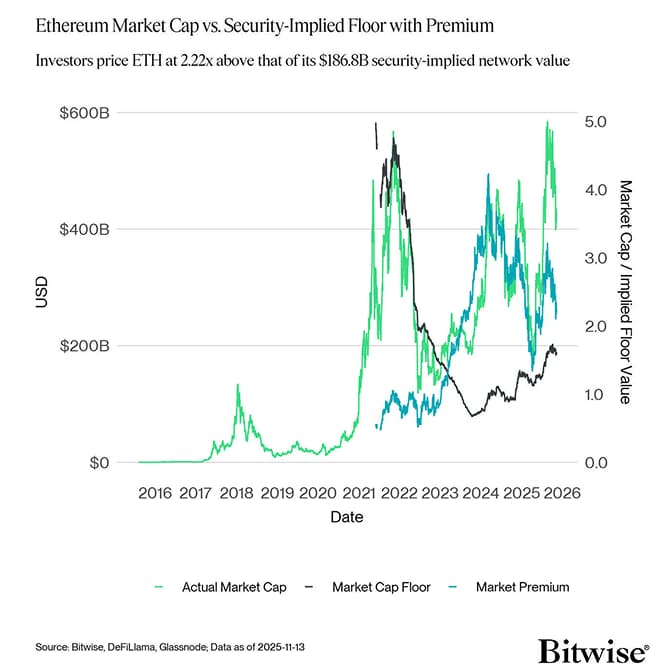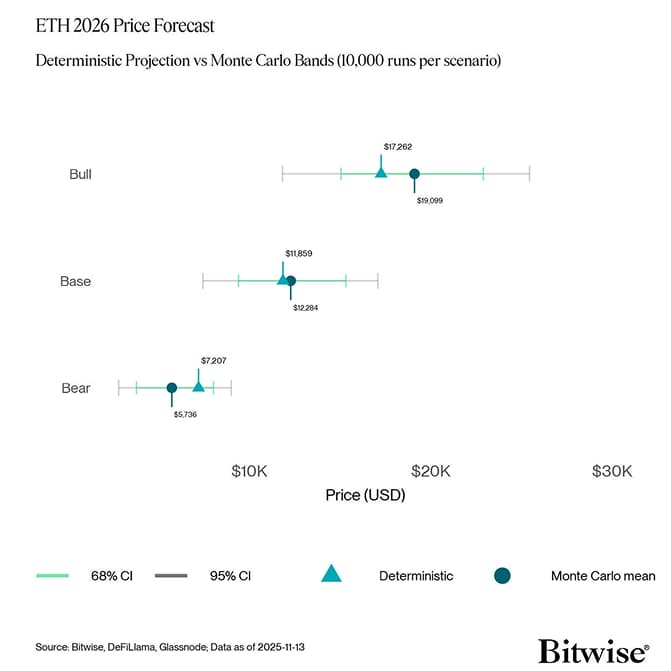- Based on the Cost to Corrupt model, Ethereum's projected value for FY 2026, 2028 and 2030, respectively, are $12.8k, $20.2k, $30k. If accurate, a buy-and-hold approach at current levels, particularly when market sentiment is weak, would deliver strong longer-term returns.
- Historically, price has not tracked the Cost to Corrupt model closely.
- Validators imply that roughly half of all on-chain capital should be secured by staked ETH. However, we believe this ratio should decline over time, as additional staking provides diminishing marginal improvements to network security.
Blockchain developers are often required to make trade-offs when balancing security, decentralisation and speed. This is commonly referred to as the “Blockchain Trilemma”.
In many cases, the most secure and decentralised blockchains tend to be the slowest Bitcoin is a prime example. Its ten-minute block time, among other factors, makes the network extremely difficult to attack over extended periods. In one hour, a malicious actor has only a six-block window to attempt an attack. Over the course of a day, this extends to approximately 144 blocks, still a relatively small attack surface. This deliberate design choice has proven remarkably effective, although it comes at the cost of speed: Bitcoin transactions are confirmed only every ten minutes.
By contrast, Proof of Stake (PoS) protocols such as Ethereum achieve significantly faster block times, with Ethereum specifically clocking in around 12 seconds. In PoS systems, network participants lock up ETH as collateral to validate and settle transactions.
Trust in a PoS system is fundamentally linked to economic factors. If the cost of an attack falls below the potential reward, Ethereum's security guarantees weaken. This represents the economic-security dilemma at the heart of Proof of Stake blockchains: a network is valuable only if it is secure, and secure only if it is valuable.
The Cost to Corrupt Model, originally proposed by ConsenSys, pulls on this thread.[1] The model reframes ETH valuation as a security-economics problem, that if Ethereum's value depends on how expensive it is to attack, then the network's “floor” price (and any consistent premium above that floor) should be predictable based on the economic resources it secures.
It's an elegant argument. Anchoring ETH's valuation to the cost of corruption matters because it shifts the perspective on “price” from a speculative measure to a reflection of how secure, and therefore how valuable, the network truly is. In this paper, we replicate, extend, and reinterpret this framework from our own perspective.
What this model is about
The core idea behind the Cost to Corrupt model is as follows. The more on-chain capital Ethereum has ---the sum of L1 and L2 stablecoin market cap, DeFi TVL and restaking AUM -- the more secure the chain needs to be. Otherwise, a bad actor is incentivised to attack the network and potentially steal assets. To mitigate this, as the amount of on-chain capital increases, validators should commit a greater amount of collateral in the form of staked ETH. This relationship is referred to as the required security ratio (RSR). This also affects the staking ratio, which is the proportion of total supply that is staked.
In summary, a higher (or lower) implied security value corresponds to a higher (or lower) level of on-chain capital, multiplied by a higher (or lower) RSR, and divided by a lower (or higher) staking ratio. Then to predict an overall ETH price, we embed a market premium above that of its implied security floor.
Assumptions
The Cost to Corrupt model uses this relationship as its foundation. When modelling prices using this framework, a few main assumptions must be made:
- How much value will the Ethereum network secure in the future? We use the growth rate observed since the Merge on September 2022. We believe this represents a realistic trajectory.The Merge serves as a common, standardised reference point for many of our metrics, as it marks one Ethereum's transition to Proof of Stake.
- How much Ethereum will be staked, both nominally and as a percentage of circulating supply? We estimate staking ratio using staked ETH, circulating supply and one-year CAGR to minimise distortion.
- What will the future supply of Ethereum be? The circulating supply projection is based on the post-Merge CAGR as well, adjusted for the burn mechanism.
- How much security does the network require to support the capital that sits on top of Ethereum? The required security ratio (RSR) uses the same methodology as the market premium.
- How close does Ethereum's market cap track its underlying security value? The market premium is derived from the difference between Ethereum's actual market cap and its implied security value. This can be inferred from both historical figures. To project scenarios for future bear, base and bull case scenarios we use the 365-day rolling market premium percentiles (P25, median, P75), representing how richly the market has paid above the floor in each sentiment regime.
What is Ethereum's implied security value?
Currently, Ethereum's implied security value is around $186bn, which equates to a price of $1539. This has grown at a 50% two-year CAGR, yet declined heavily from late 2021 to early 2024 mainly due to the collapse in DeFi TVL in the year 2022, following the failures of Celsius, Three Arrows Capital (3AC), FTX, and Terra Luna, among others. These events forced investors to withdraw liquidity from the crypto ecosystem, exerting downward pressure on Ethereum's implied security floor because the network is inherently less valuable.
At the same time, the amount of staked ETH rose sharply following the Beacon Chain launch in 01/12/2020, which meant the staking ratio continued to increase, lowering the needed and implied security floor, as it became more difficult and capital-intensive to acquire at least 33% of the network's stake under those conditions.
Between 2023 and 2024, a significant divergence emerged between the implied security floor and Ethereum's actual market capitalisation. Liquidity that exited during the 2022 bear market struggled to return, even as price and sentiment recovered.

How has ETH traded versus its implied security value?
The market premium above the implied security floor reflects how much investors are willing to pay for Ethereum's residual value. That is, the portion of the market capitalisation not explained purely by security fundamentals. Over the past 12 months, investors have priced Ethereum's network market cap at an average of 2.47x above its implied security value. This premium accounts for Ethereum's growth expectations stemming from its technological prowess as a decentralised, permissionless and global computer for finance on-chain. The fluctuation of the market premium also considers factors such as competition, investor sentiment, liquidity cycles, and macroeconomic conditions.
Will this dynamic persist?
Ethereum's implied security value should continue to rise as both the on-chain capital base and the amount of staked ETH expand, making the network more secure and, consequently, more valuable. As such, Ethereum is likely to trade above its implied security value, as investors recognise the strength of its underlying security reflected in the market premium. Security will become increasingly important if trillions of dollars of capital move on-chain and rival networks fail to offer comparable resilience.
Further, there is a case that as the number of validators and the amount of staked ETH increase, the yield per validator declines to a point where staking becomes progressively less attractive. Operational risks, such as the exit queue and the possibility of accidental slashing, may begin to outweigh the incentives. Over time, the proportion of staked ETH supporting on-chain capital could fall, reducing the implied security value and floor price of the network and widening the gap between intrinsic and market valuations.
Price Targets for the Cost to Corrupt Model
Using Monte Carlo simulations, the Cost to Corrupt model arrives at the following price targets, using a mean of all 10,000 draws a range within 68% and 95% confidence intervals. The simulation does not account for macroeconomic shocks, demand shifts, or structural regime changes. The model is inherently conditional, as it simply recombines recent fundamental data. Adjust the merge-era TVS CAGR, the percentile lock-ins, or the bucket definitions and the Monte Carlo averages and ranges will change materially. In addition, the market premium is a significant input, representing roughly 60 per cent of overall valuation on average over the past year. When considering both bull and bear cases, this premium can materially skew the resulting scenarios.
- End of 2026 = Bear = $7.5k, Base = $12.8k, Bull = $20.4k
- End of 2028 = Bear = 9k, Base = 20.2k, Bull = 37.3k
- End of 2030 = Bear = 10.8k, Base = 32k, Bull = 75.6k

What do statistical models show?
The cost-to-corrupt model is logically elegant, but it's important to consider how it looks from a data perspective: Does real-world experience support the value of this model? When we first compared Ethereum's market capitalisation and the amount of liquidity on-chain, the relationship appeared strong. A simple regression on their raw levels produced an R² of about 55%, suggesting that over half of the variation in market cap could be explained by the amount of on-chain capital. In reality, this was an illusion. Both variables trend upward over time, so the high R² mainly reflected shared long-term growth, not a genuine causal link, a classic example of a spurious regression.
To correct this, we looked at percentage changes instead of raw levels by taking log differences. This removed the trend and focused on short-term movements. Once we did that, the R² collapsed to just 0.3%, meaning Ethereum's on-chain capital base explains only a tiny share of short-term market cap changes. The coefficient of 0.19 means that a 1% rise in on-chain capital corresponds to about a 0.19% rise in market cap, a small but statistically significant effect (p ≈ 0.02). The differenced series were stationary, and diagnostic tests confirmed no major issues with autocorrelation or heteroskedasticity. So although the relationship is weak, it's statistically sound.
We then tested for a long-run equilibrium using the Johansen cointegration approach. The trace statistic (44.5 vs. a critical value of 19.96) confirmed a stable link between on-chain capital and market cap over time. The estimated long-run elasticity of 0.37 means that, in equilibrium, a 1% increase in on-chain capital is associated with a 0.37% rise in market cap. However, the speed of adjustment was tiny (–0.004), showing that when the market moves away from this equilibrium, it takes a long time to realign. In essence, price tends to drift, not quickly revert.
Shortcomings and benefits of the model
First, the spurious and autocorrelated nature of the model stems from the fact that two of the three variables share similar inputs and some mathematical overlap, which introduces a degree of skew and causes certain statistical tests to underperform, which is why we believe it partly explains why the price projections appear perhaps optimistic. That said, we chose not to adjust the projection assumptions, as they are intentionally simple and, in my view, reasonably conservative. Over engineering assumptions can lead to an overfit, and not realistic model. We tried to avoid this.
On the other hand, the underlying concept of reframing ETH's valuation through the lens of its security value is compelling. It aligns closely with the narrative that Ethereum could serve as the global decentralised settlement layer for financial activity. The simplicity of the Cost to Corrupt framework strengthens its appeal, as it relies on just three core variables that capture Ethereum's economic fundamentals: the future value of the on-chain capital base, the future value of staked ETH, and the network's supply dynamics, which incorporate the burn mechanism.
The relationship between market capitalisation and on-chain capital base is cointegrated, suggesting that while Ethereum's market capitalisation and its on-chain capital base may diverge in the short term, they tend to mean-revert and move in the same long-term direction. This dynamic supports the notion that Ethereum's market value is anchored to the real economic activity occurring on-chain. Assuming continued adoption, this relationship provides a credible basis for long-term price modelling.
In a fast and rapidly evolving asset like Ethereum, there are no perfect statistical models; this is not equities, where the world has coalesced around discounted cash flows as the proper model for uating all stocks. The value of the cost-to-corrupt model is that it provides one logical frame for considering the underlying value of the Ethereum network: People rely on the network to store valuable assets, so the value of the network must be high enough for those assets to be secure. It is hard logic to question.
The data show that the relationship between the price of ETH and the cost-to-corrupt valuation varies significantly, and that is likely to continue over time. We do not think this is the only input to ETH's value, but rather, an important one.
Bottom Line
- Based on the Cost to Corrupt model, Ethereum's projected value for FY 2026, 2028 and 2030, respectively, are $12.8k, $20.2k, $30k. If accurate, a buy-and-hold approach at current levels, particularly when market sentiment is weak, would deliver strong longer-term returns.
- Historically, price has not tracked the Cost to Corrupt model closely.
- Validators imply that roughly half of all on-chain capital should be secured by staked ETH. However, we believe this ratio should decline over time, as additional staking provides diminishing marginal improvements to network security.
Important information:
This article does not constitute investment advice, nor does it constitute an offer or solicitation to buy financial products. This article is for general informational purposes only, and there is no explicit or implicit assurance or guarantee regarding the fairness, accuracy, completeness, or correctness of this article or the opinions contained therein. It is advised not to rely on the fairness, accuracy, completeness, or correctness of this article or the opinions contained therein. Please note that this article is neither investment advice nor an offer or solicitation to acquire financial products or cryptocurrencies.
Before investing in crypto ETPs, potentional investors should consider the following:
Potential investors should seek independent advice and consider relevant information contained in the base prospectus and the final terms for the ETPs, especially the risk factors mentioned therein. The invested capital is at risk, and losses up to the amount invested are possible. The product is subject to inherent counterparty risk with respect to the issuer of the ETPs and may incur losses up to a total loss if the issuer fails to fulfill its contractual obligations. The legal structure of ETPs is equivalent to that of a debt security. ETPs are treated like other securities.

